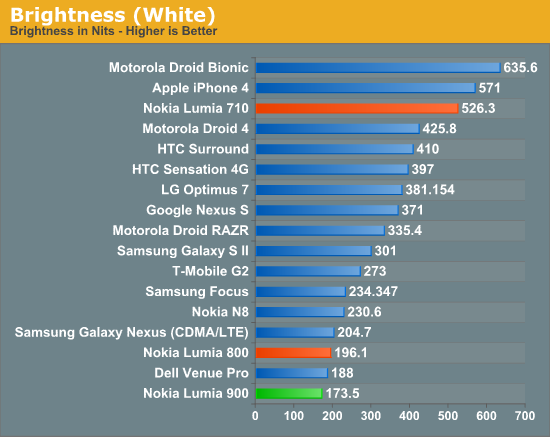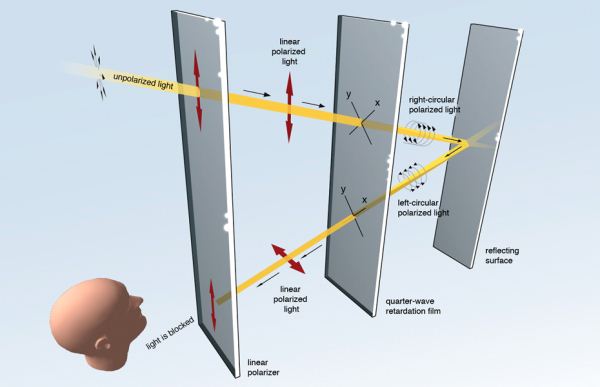Nokia Lumia 900 Review - Windows Phone with LTE
by Brian Klug on April 3, 2012 9:00 PM ESTDisplay Quality
Like the Lumia 800, the Lumia 900 uses an AMOLED display instead of an LCD. One of the chief differentiators between the two models however is the difference in subpixel rendering. Whereas the Lumia 800 used a 3.7“ PenTile RGBG SAMOLED panel, the Lumia 900 uses a 4.3” SAMOLED+ panel with an RGB subpixel stripe. Those names fit, that is, if we’re following Samsung’s naming scheme, and as an aside this is undoubtedly a Samsung panel.
The effective resolution of both displays are 800x480 WVGA, like all Windows Phones, however. Jumping up in display size pretty much necessitates that change to RGB, since PenTile really only works when subpixels are below human visual acuity. In addition, we’ve already seen 4.3" SAMOLED+ WVGA displays out of Samsung (see the Focus S).
I measured the Lumia 900 display using an i1D2 just like I’ve done with numerous other smartphones, though at this point the advanced color and gamut information will have to wait until I make some targets. Again, because AMOLED is emissive, black color pixels are literally off, so contrast graphs are omitted. The Lumia 900 doesn’t go super bright, like other AMOLEDs I’ve seen. In fact, it’s slightly dimmer than the Lumia 800’s maximum of 196 nits. Remember that going to a larger display, especially AMOLED due to its emissive nature, increases power demands as r^2 since we’re talking about areal size.
| Lumia 900 Display Metrics | |||
| Brightness Level | Black Brightness (nits) | White Brightness (nits) | White Point (K) |
| Low | 0 | 72.68 | 6635 |
| Medium | 0 | 140.06 | 6930 |
| High | 0 | 173.55 | 6812 |
Nokia was able to get the Lumia 900 display nice and close to 6500K, which is interesting considering how many other AMOLED displays I’ve seen which are up near 8000K or higher and noticeably blue all the time.

I glossed over ClearBlack on the previous Lumia reviews partly due to time constraints, partly due to not knowing the exact details of their optical path. That said, it was immediately obvious that the system used circular polarization’s behavior upon reflection to attenuate back reflections. However, since writing those reviews, Nokia has outlined their optical system in a conversations post, and the long and short of it is that the system consists of a linear polarizer and quarter-wave plate.
Incoming diffuse light gets vertically polarized by a surface polarizer, which becomes right hand circularly polarized when passing through the quarter wave plate. When circular polarized reflects off of a surface, it changes handedness - in this case from right to left handed circular. Upon passing through the quarter wave plate on its way out, this becomes horizontally polarized, which is then strongly attenuated by the surface polarizer with its fast axis aligned vertically on its way out, which acts like an analyzer. The end result is that outdoors the only reflection you’ll get is from the first surface, not the surface of the display itself, which does reduce resulting glare.
This change also permits the Lumia 900 to still look bright outside, and in turn allows Nokia to run the display at a lower brightness and save some amount of power. For a while I was waiting for some OEM to introduce a system using polarization to diminish back reflections, and Nokia has done it with ClearBlack.
Indoor viewing angles for the Lumia 900 are excellent as evidenced by the purple test pattern from WP Bench not changing color at extreme field angles. In addition, I subjectively can’t find any issues with the display - there are none of the other problems that affect the higher dot pitch AMOLEDs such as grain or mura. Outdoor viewing angles are likewise good for the Lumia 900 in part thanks to ClearBlack.

















128 Comments
View All Comments
sonicmerlin - Saturday, April 7, 2012 - link
Also even on the S4 Android isn't smooth. Look at how much of a delay occurs between when you swipe your finger and the screen finally responds with movement. There's really just no comparison to a proper OS that prioritizes the UI thread.crispbp04 - Wednesday, April 4, 2012 - link
I have the HTC titan and I use it all day every day. It's always fast, always smooth, always fun to use, and if I forget to plug it in at night I can still use it the entire next day. Android made me want to punch myself in the face after it turned to junk after 2 weeks. I was flashing a new rom on it every other day and spending hours customizing it.... now I get to spend that time actually ENJOYING my phone.I have never once said "I wish my phone was faster". I've never felt like my phone needed a dual core because WP7 has an awesome staff of engineers making sure the user experience is the #1 focus.
I am getting the Lumia 900 because it has LTE and is one sexy ass phone. I'm waiting for the white one to launch though because it is absolutely gorgeous. I am going to whore out my Titan to my friends who have been dying to try out the WP ever since I got it.
Beerfloat - Wednesday, April 4, 2012 - link
The experiences you claim seem highly exaggerated at best. Is this a genuine post or more astroturf?http://www.moneylife.in/article/nokia-lumia-800-wh...
crispbp04 - Tuesday, April 10, 2012 - link
I can demo my phone to you if it'll make you feel better. Want me to make a youtube video for you? I have the following devices:1) HTC HD2 running windows phone mango
2) Samsung focus
3) HTC Titan
4) Blackberry Bold (work phone)
I went to the AT&T store and did NOT purchase the lumia only because the Ttitan II was so much better than I expected. Now I am waiting until the white lumia comes out to see if it sways me back to the lumia, otherwise I'm getting the Titan II
bplewis24 - Tuesday, April 3, 2012 - link
@ visionYou either don't know what you're doing or have no idea what you're talking about. You should probably stop posting FUD and flat out lies.
Iketh - Tuesday, April 3, 2012 - link
I have both an Android (wife uses it) and WP device, and Android absolutely sucks. It's getting replaced as soon as AT&T allows it.Vision is 100% accurate.
jmcb - Tuesday, April 10, 2012 - link
The problem with vision's post is he said every Android phone he's used. Well...... every Android phone he's used does not equal all Android phones.I can tell you that Android doesnt absolutely suck...thats just your opinion. WP7 might be smoother, has less lag than most Android phones....but that doesnt make up the entire user experience.
Kids mother has a Nexus S and an iPhone 4. She likes her iPhone 4 more cuz she says the Nexus S sticks, gets stuck too much. I assume she means lag. After using both....I would go with the Nexus S. Based on my wants n needs.
One thing we gotta remember is everybody doesnt have the same wants n needs. If that was the case...we would all have iPhones now. I'm talking about before Android even came out.... we would all have iPhones.
sprockkets - Wednesday, April 4, 2012 - link
"Well, in general if Android doesn't suck so much none of us really need a quad-core phone. Clearly WP is much more efficient platform than Android today so a single-core phone can be this solid and for most people this translates to feeling faster than most Android phones that lags when apps are running and sans performance."It's called the GUI is GPU accelerated. Already solved in ICS. It was sorely needed, yes. But I'm willing to bet people will still harp about this even with the HTC One series and new Samsungs come out.
"Nearly every Android device I've used today needs manual management in order to run smoothly. Letting a single widget or app sitting background too long, battery life and performance suffers. Android's entire ecosystem is to blame for faulty app coding to OS builds rigged with bloatware."
Sorry to hear that one widget is killing your phone. I have 3 of them and I'm on to day 3 of my battery life with 3G and Wifi on with sync.
"Bloatware" is also no longer an issue either with ICS.
Hey, whatever floats your boat, go with it. I personally cannot tolerate the GUI on WP7 past 2 minutes.
eddman - Wednesday, April 4, 2012 - link
"It's called the GUI is GPU accelerated. Already solved in ICS."Actually it was/is not just that. It's an underlying OS issue.
http://www.inspiredgeek.com/2011/12/07/why-android...
For a fair comparison, flash ICS on a 1 GHz single-core (preferably snapdragon) android phone with 512 MB memory and then compare to a 1 GHz WP.
Exodite - Wednesday, April 4, 2012 - link
You don't need ICS for Android to compare well in such a situation, you just need a device that has had at least moderate optimizations towards the actual hardware.Ie. probably not a LG device, or one mangled too much by the carrier.